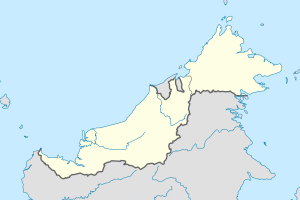East Malaysia facts for kids
East Malaysia, often called Malaysian Borneo, is the part of Malaysia located on the large island of Borneo. This region includes the states of Sabah and Sarawak, along with the small federal territory of Labuan. It sits north of Indonesian Borneo (which is called "Kalimantan") and southwest of the Philippines. The tiny country of Brunei is also almost completely surrounded by East Malaysia.
Contents
What is East Malaysia?
East Malaysia is one of the two main parts of Malaysia, with the other being Peninsular Malaysia (West Malaysia) on the Malay Peninsula. These two parts are separated by the South China Sea. East Malaysia is much larger in land area than Peninsular Malaysia, but it has fewer people. It's famous for its amazing rainforests, tall mountains, and incredible wildlife.
Geography and Landscape
Mountains and Rivers
East Malaysia is home to some of the tallest mountains in Southeast Asia. The most famous is Mount Kinabalu in Sabah, which is the highest peak on Borneo. These mountains are part of a large mountain range that runs through the island. Many important rivers also flow through East Malaysia, like the Rajang River in Sarawak, which is the longest river in Malaysia. These rivers are like highways for people and wildlife, especially in the dense rainforests.
Rainforests and Caves
A huge part of East Malaysia is covered by ancient rainforests. These forests are millions of years old and are incredibly rich in different kinds of plants and animals. They are often called "lungs of the Earth" because they produce so much oxygen. Deep within these forests, you can find massive cave systems, like the Mulu Caves in Sarawak. These caves are some of the largest in the world and are home to millions of bats and other unique creatures.
Wildlife and Nature
East Malaysia is a paradise for nature lovers. Its rainforests are home to many animals that you won't find anywhere else in the world.
- Orangutans: These amazing "people of the forest" are one of Borneo's most famous residents. You can often see them in wildlife sanctuaries.
- Proboscis Monkeys: These monkeys are easy to spot because of the male's very large, long nose! They usually live near rivers.
- Pygmy Elephants: The smallest elephants in Asia, found only in Borneo.
- Rafflesia Flower: This is the largest flower in the world, known for its huge size and unique smell.
Protecting these animals and their homes is very important, and there are many national parks and wildlife reserves in East Malaysia working to do just that.
People and Culture
East Malaysia is a melting pot of different cultures and ethnic groups. While Malay people are present, a large part of the population belongs to various indigenous groups, often called Dayaks in Sarawak and Kadazan-Dusun in Sabah.
- Dayaks: This is a general term for many native groups in Sarawak, like the Iban, Bidayuh, and Orang Ulu. They have rich traditions, including unique longhouses (traditional communal homes) and colorful festivals like Gawai Dayak (Harvest Festival).
- Kadazan-Dusun: These are the largest indigenous group in Sabah. They are known for their farming skills, especially rice cultivation, and their own harvest festival, Kaamatan.
Besides these groups, there are also many Chinese, Indian, and other communities who have lived in East Malaysia for generations, adding to its diverse cultural fabric. This mix of cultures makes East Malaysia a vibrant and interesting place to visit and learn about.
Economy
The economy of East Malaysia relies on several important industries.
- Natural Resources: The region is rich in natural resources like oil and natural gas, which are important for Malaysia's economy.
- Agriculture: Palm oil and rubber plantations are common, providing jobs and products.
- Timber: Logging has historically been a big industry, though efforts are now made to manage forests more sustainably.
- Tourism: With its stunning nature, unique wildlife, and diverse cultures, tourism is growing rapidly. People come from all over the world to climb Mount Kinabalu, explore rainforests, dive in clear waters, and experience local traditions.
Major Cities
The two largest cities in East Malaysia are:
- Kuching: The capital of Sarawak, known for its charming old buildings, riverside promenade, and cat statues (Kuching means "cat" in Malay).
- Kota Kinabalu: The capital of Sabah, a bustling city and a gateway to Mount Kinabalu and the beautiful islands nearby.
These cities are modern hubs with airports, shopping malls, and universities, but they still keep a strong connection to the natural beauty and cultural heritage of East Malaysia.
Images for kids
See also
 In Spanish: Malasia Oriental para niños
In Spanish: Malasia Oriental para niños




